This post contains affiliate links. Please see our disclosure policy.
While aging is inevitable, aging well is not. There are many factors involved in maintaining good physical and mental health as you age, but one of the most important things to consider as you grow older is weight training. The below strength training exercises are proven to get results for women over 50.
I’ve been a personal fitness trainer for over 35 years. My body has aged right along with my clients. I know from personal experience that strength training not only keeps you feeling and looking younger and stronger but physically slows down the aging process.
And while exercise comes in many forms, strength training is where the true anti-aging magic happens. Muscle is the secret to metabolism, having energy, sleeping better, maintaining weight and balancing hormones. Strength training is one of the best types of exercises for women over 50 – it’s time to start!
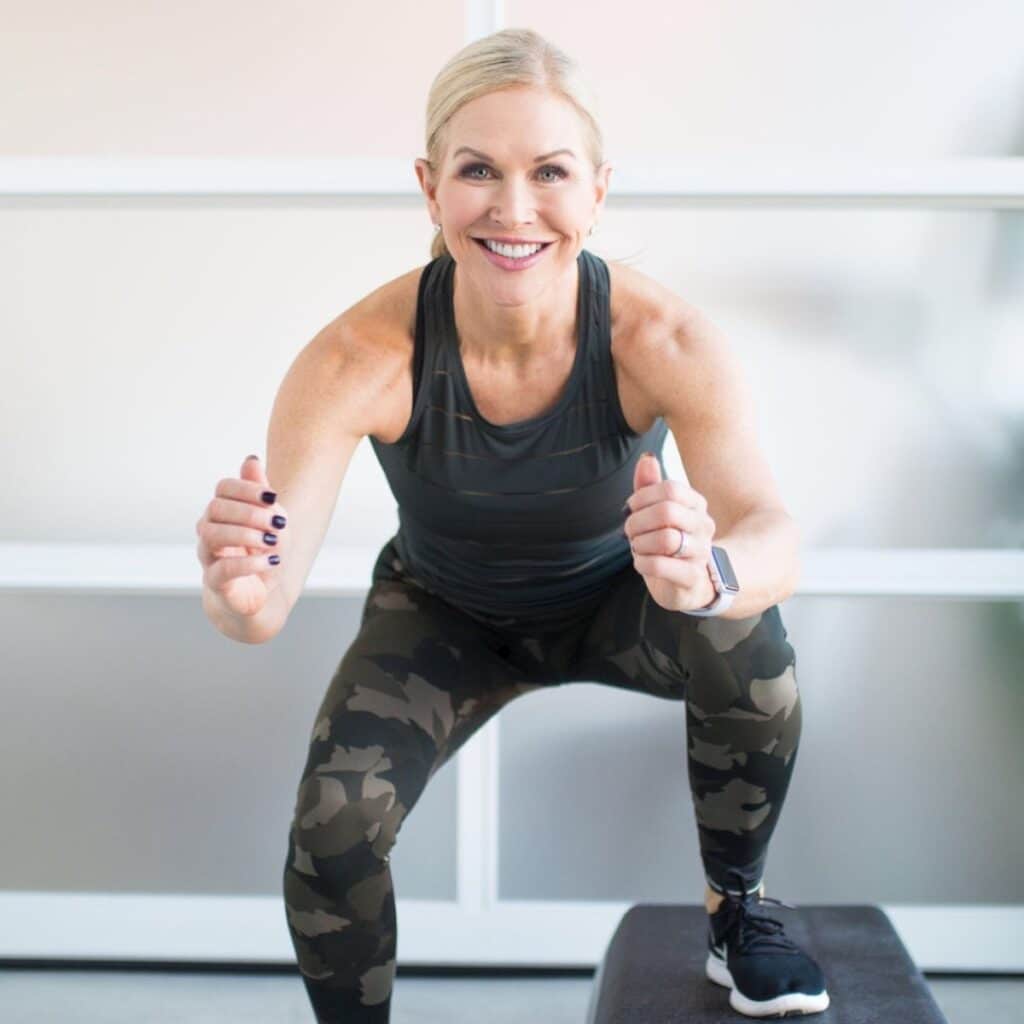
Save This Article To Read Later
11 Best Strength Training Exercises for Women Over 50
Here are 11 strength training exercises for women over 50 that will work for every muscle group and give you a good total body workout. Several exercises use your body weight, and a few require a set of dumbbells. They’re also a great way to target the best opposing muscle groups to work out together.
Choose a weight that allows you to complete 12-15 repetitions of each exercise reaching fatigue by that last repetition. If the exercise feels too easy, go a little heavier.
If you’re not sure how heavy to go with your dumbbells, check out my guide for understanding when to increase your weights!
Workout Instructions
- Perform each exercise shown below anywhere between 12 and 15 repetitions.
- Repeat the entire circuit of the 11 strength training moves a total of 2 times through the circuit. Between each circuit, take a 1-minute break to grab your breath and start back from the top.
1. Basic Squats
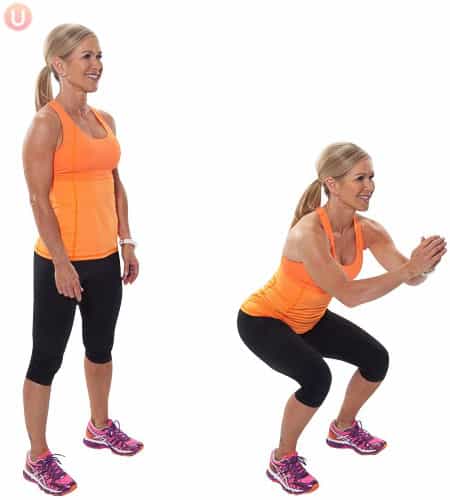
Here’s how to perform a basic squat:
- Stand tall with your feet hip-width distance apart. Hips, knees, and toes all pointing forward.
- Bend your knees and sit your butt back as if you are going to sit in a chair. Primarily keeping your weight equally in both heels, allowing you to keep your knees behind your toes.
- Hit the bottom of your squat, pause, and then rise back up to stand and repeat the full exercise.
Muscles Targeted: Quads, Hamstrings, Glutes, and Core
2. Modified Push Up
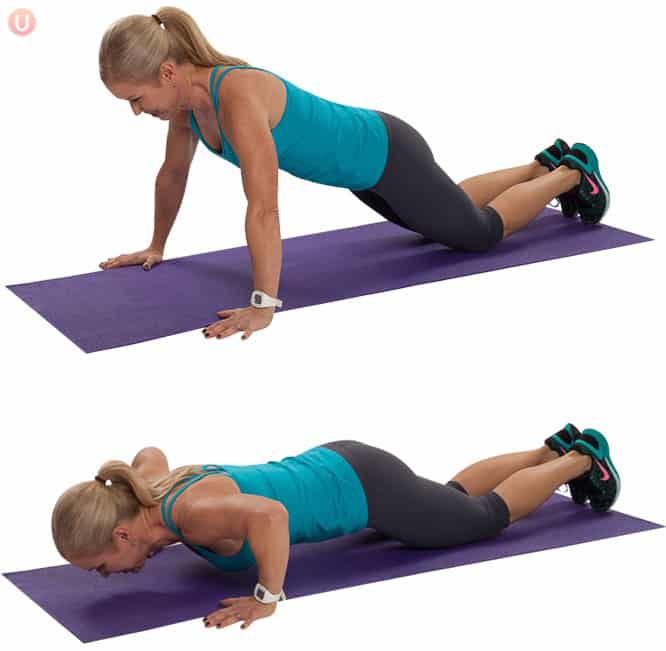
Here’s how to perform a modified push-up:
- Begin in a kneeling position with your hands below your shoulders and knees back behind your hips.
- Keep your gaze in front of your fingertips so your neck stays long, squeeze your glutes and inner thighs together, keeping the lower body active.
- Slowly lower yourself to the ground, keeping your elbows back at about a 45-degree angle.
- Press yourself back up to the starting position
- Repeat for the desired amount of repetitions
Advancement to this Exercise: Once you have mastered the modified push-up try a full push-up from your toes.
Begin in a high plank position, hands stacked underneath the shoulders, legs long behind you. Lower your chest to the floor, with your elbows pointing slightly back, until you are just above the ground.
As you exhale, tighten your belly and push yourself back up to a plank position.
Muscles Targeted: Upper Body, Chest, Back, Shoulders, Biceps and Triceps, and even your Core.
3. Reverse Grip Double Arm Row

Here’s how to perform a reverse grip double arm row:
- Start this exercise with your legs together and sit back into a small squat; engaging the glutes and abdominal wall. Arms will be stretched out in front of the body holding the weights with the palms facing the ceiling.
- Drawing your elbows back by squeezing your upper back muscles together, pull the elbows gently past the hips so you feel the lats and triceps engage and return to the starting position with control.
Options: Start with a lighter set of weights and focus on slow-controlled movements. Take a 3-second pause at the top of the range of motion and slowly return to the starting position.
Muscle Groups Targeted: Upper Body, Triceps, Back, and Shoulders
4. Full Body Roll-Up

Here’s how to perform a full-body roll-up:
- Start lying on a mat (or the ground) with your arms extended overhead, legs long, and feet flexed towards your face.
- Inhale as you lift your arms up and begin curling your chin to your chest. Exhale as you roll the entire torso up and over, keeping your legs straight, abs engaged, reaching down towards the toes.
- Inhale as you begin to roll back down your spine, one vertebra at a time, and exhale as the upper portion of the back lowers to the ground, reaching your arms back overhead.
- Repeat moving slowly and using the abdominals to lift and lower, not using momentum.
Muscle Groups Targeted: Core, Shoulders, and Back
5. Dumbbell Deadlifts
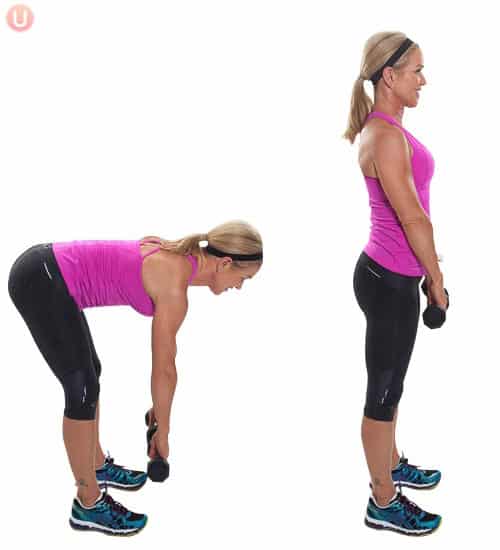
Here’s how to perform a Dumbbell Deadlift:
- Start standing with your feet hip-width distance apart and weights facing towards the front of your thighs.
- Tighten your abdominals and keep a flat back as you bring a soft bend through the knees, lowering the dumbbells towards the floor.
- Send your butt backward with a slight hip hinge, squeeze the glutes, and use your hamstrings to lift and return to your upright position.
Muscle Groups Targeted With This Exercise: Hamstrings and Glutes
6. Forward Lunge with Bicep Curls
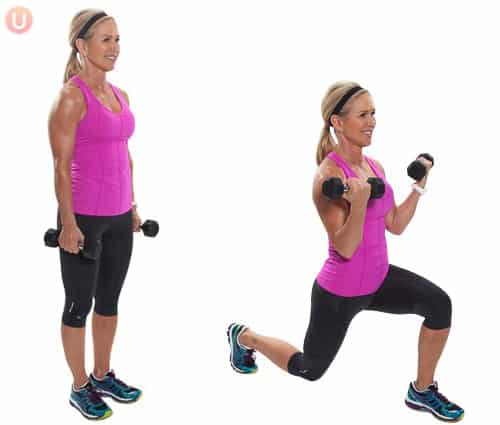
Here’s how to do a Forward Lunge with A Bicep Curls:
- Start standing tall with your feet hip-width distance apart. Take a large step forward with the right leg and lower your back knee down to the floor. Both legs should be bent at a 90-degree angle at the bottom of the lunge.
- Bring weights in towards your shoulders to complete the bicep curl at the bottom of the lunge, then push off the front foot and return to the starting position.
- Repeat on the other side.
Muscle Groups Targeted: Quads, Glutes, Hamstrings, and Biceps
7. Forearm Plank

Here’s how to hold a forearm plank:
- Begin by lying on the floor with your forearms flat on the ground. Your elbows should be aligned directly below your shoulders. Hands should be separated by the width of your elbows.
- Engage your core, press down through your elbows, and raise your body up off the floor, keeping your body in a straight line from your head down to your feet. Pull your navel into your spine and squeeze your glutes to keep your hips in line with your shoulders.
Hold for 30 seconds to 1 minute.
Modifications to this Exercise: Drop down to your knees and hold from your forearms and your knees. This will allow you to focus on squeezing your belly into your spine without dropping your hips or dumping pressure into your low back.

Muscle Groups Targeted with This Exercise: Core/ Abdominals, Shoulder, Chest, Upper Back, Arm, and Leg Muscles.
8. Single Leg Hamstring Bridge
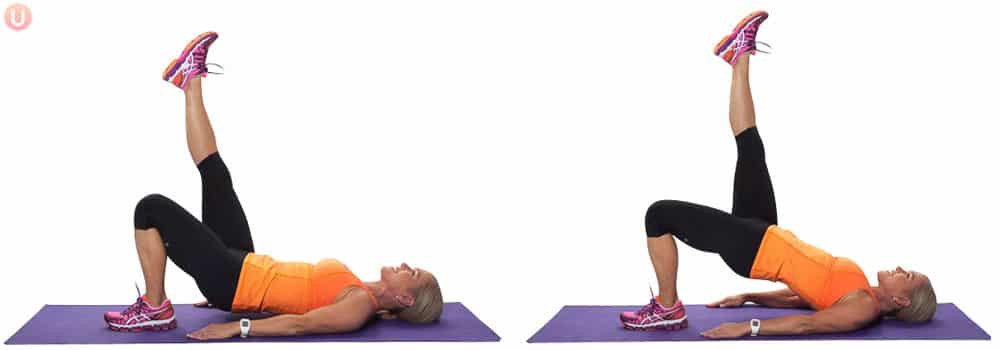
Here’s how to perform a single leg hamstring bridge:
- Lie on your back with bent knees both hip-width distance apart. Your feet will be flat on the mat stacked underneath your knees. Once in a bridge position, extend your right leg long towards the ceiling.
- Squeezing your glutes and lower body and then lifting your hips off of the mat into a bridge. Lower and lift the hips for a desired number of reps and then repeat the exercise on the left leg.
A modification is to keep both feet on the ground during the bridge but if you are up for it, try the single leg option to intensify this exercise.
Muscle Groups Targeted: Hamstrings, Glutes, and Quads
9. Tricep Kick Back
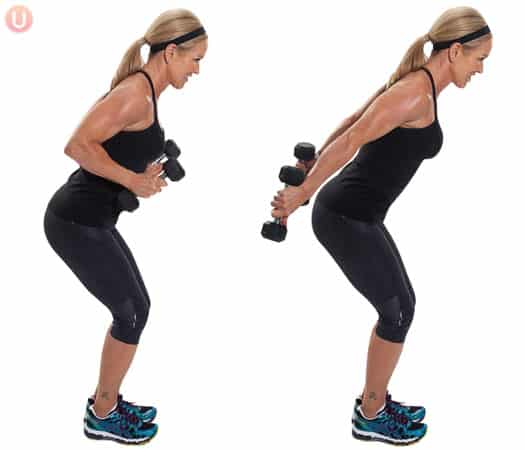
Here’s how to perform a tricep kickback:
- Start with your feet together (or hip-width distance apart), sit back into a slight squat with arms bent at 90-degree angles, and weights at the sides of the chest.
- Press the dumbbells back past the hips, keeping the line from your shoulder to your elbow joint stable and only finding movement from the elbow joint to the dumbbell. Return back to the starting position with weights at 90 degrees.
Advanced Option: Stability Ball Tricep Kick Back
For a fun advanced move, add a stability ball to your tricep kickbacks to not only strengthen your triceps but also challenge your core stability.
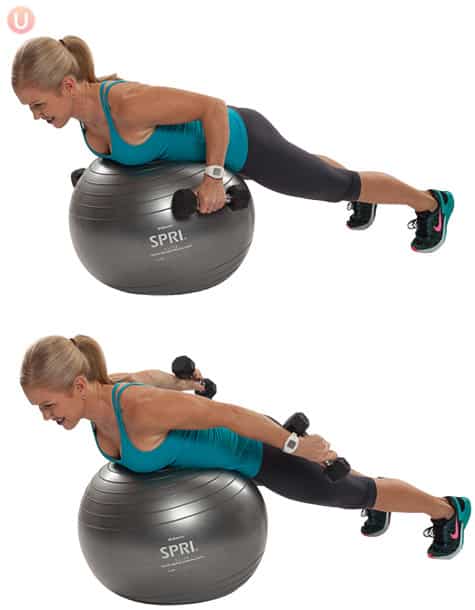
Here’s how to do a stability ball tricep kickback:
- Holding dumbbells, place your chest firmly on the ball with arms draped along your side body and legs extended on the floor behind you. Keep your head in line with your spine, squeezing your glutes to hold yourself in a stable plank position on the ball.
- Pull your elbow up to a 90-degree angle for the starting position of the tricep kickback.
- Press the dumbbell back, squeezing the triceps.
- Release weights back down to starting position, maintaining balance on the stability ball the entire time.
Muscle Groups Targeted: Triceps and Core.
10. Shoulder Overhead Press

Here’s how to perform a shoulder overhead press:
- Start with your feet hip-width distance apart. Bring your elbows out to the side creating a goal post position with your arms. Elbows will be straight out from shoulder height and abdominals held in tight.
- Press dumbbells straight overhead until your arms are straight. Slowly return to starting position (goal post arms) with control.
Muscle Groups Targeted: Shoulders
11. Bird Dog
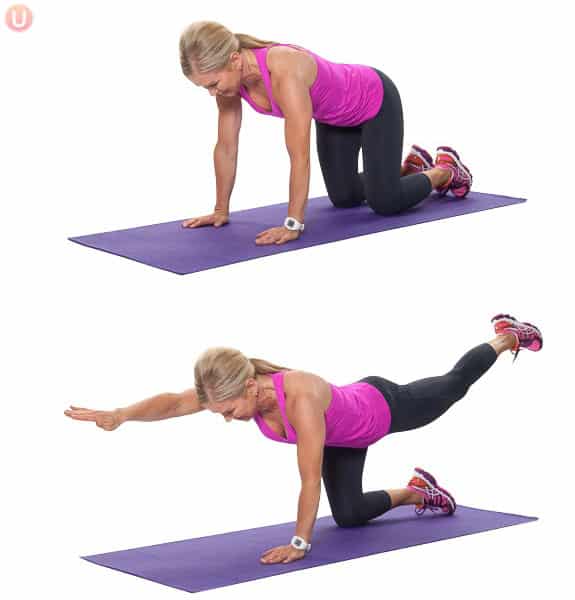
How to perform bird dog:
- Kneel on a mat (or any soft surface) on all fours
- Reach one arm long, drawing in the abdominals, and extend the opposite leg long behind you.
- Hold, engage your lower body for 5-10 seconds, and return to all fours.
- Repeat on the other side.
Muscles Groups Targeted: Abdominals and Low Back
Try These Strength Exercises Two Different Ways
1. 10-Minute AMRAP Workout
(As Many Rounds as Possible Workout) – Set a timer for 10 Minutes. Complete a total of 10 repetitions of each exercise above. Repeat as many times as possible within 10 minutes.
Take breaks as needed – the goal is to get through as many rounds as you can of all strength exercises in the 10 minutes.
2. Circuit Workout
In this circuit workout, we are going to bundle a few of the exercises together and you will repeat each circuit 2 times.
- Complete Exercises 1 – 4 together: You will complete 10 repetitions of each exercise (squats, mid-back rows, modified push-ups, and the full-body roll-up) and repeat the circuit again for a total of 2 rounds.
- Complete Exercises 5 – 7 together: After completing 2 rounds of exercises 1 – 4, you will move on to exercises 5 through 7. Completing 10 repetitions of each (deadlift, lunges with bicep curls, and 1 minute of a forearm plank) and repeat the circuit for a total of 2 rounds. If you need to modify the forearm plank you can adjust the time down to 30 seconds or drop down to your knees and continue to engage your core.
- Complete Exercises 8 – 11 together: After completing the first 2 circuits, you will move on to the third circuit which consists of exercises 8 through 11 (single leg hamstring bridge, tricep kickback, shoulder overhead press, and bird dog). Complete 10 repetitions of the 4 exercises and repeat the circuit one more time!
7 Reasons Why Is It Important to Strength Train After 50
I sound like a broken record but as a 58 year old woman, I know firsthand that women who consistently strength train look, feel and move better. Muscle is the secret to aging well and keeping independent and mobile.
1. Weight Training For Women Builds Lean Muscle Mass
As we get older, our bodies inevitably go through muscle loss if we’re not focused on a strength training workout regularly. We women lose approximately a half pound to a full pound of muscle a year after the age of 35 if we are not actively replacing it. Those who strength train see tighter, more toned bodies.
And, it’s a myth that weight training will make you bulk up. Muscle is a more dense, metabolic tissue than body fat and takes less space. It will, in fact, help you achieve that coveted sculpted appearance everyone wants.
Cardio workouts help burn calories and get your heart pumping, which is critical for your overall heart health and weight management. But strength training is the secret to aging gracefully and feeling capable.
Being stronger means you can stay independent and strong for life’s daily activities such as carrying groceries, lifting grandchildren, or engaging in fun activities like golf or other sports.
And, there is no pill to take or potion to drink that builds muscle. You have to do the work.
2. Weight Training For Women Builds Bone Density & Reduces Injury Risk
Muscle loss can have further consequences on bone health. Unexpected falls put countless older people in the hospital every year.
In fact, according to the CDC, falls are the leading cause of injury and death in older Americans.
By training the muscle and connective tissue that surrounds your bones, you are making yourself stronger and helping to prevent a fall from happening in the first place. Bone density is a big deal and strength training is the best way to preserve it.
The stronger your muscles are, the less likely you’ll be to get injured during everyday tasks or workouts.
How? Strong muscles protect your bones and joints when they’re in motion and make your ligaments better at absorbing the shock they endure during dynamic movements.
To avoid random strains and sprains, incorporate weekly strength training into your routine.
Injury prevention is important, especially as you age—and it’s an often-overlooked benefit of building muscle.
If you are already dealing with osteopenia or osteoporosis, check out these 10 osteoporosis exercises to build bone strength.
3. Weight Training For Women Decreases Body Fat
Maintaining a healthy weight is important when it comes to preventing many diseases that come with aging. Strength training can help you build muscle and paired with a healthy clean diet, can help you decrease body fat.
Strength training also creates an calorie after-burn, keeping your body churning through calories for a longer period of time after your workout than a cardio workout.
4. Weight Training Speeds Up Metabolism
It’s cruel but true – as you age, your metabolism can begin to slow down. One great way to revive it is by weight training.
Your resting metabolic rate (RMR) is how many calories your body burns at rest; the more muscle you have on your body, the higher that metabolic rate is.
Essentially, the more muscle you have, the faster your metabolism works. Let that sink in: more muscle means a faster metabolism. When you have more muscle mass in your body, you burn more calories every day even when just sitting on the couch.
5. Weight Training Improves Mental Health
Strength training is not just about more muscle mass. As you get older, you may go through a lot of life changes. Feeling strong gives you confidence, makes you feel better about your body, and helps you sleep better.
Adopting a strength training program has been shown to boost your mental health which is so important as we enter this next phase known as mid-life.
Harvard Medical School reports that exercise helps lessen the incidence and the degree of clinical depression.
6. Weight Training For Women Improves Balance, Coordination, and Mobility
Regular strengthening workouts improve your balance and coordination, which helps you do just about everything, from yoga and dance to daily tasks.
As you age, you tend to lose the overall muscle strength that allows you to balance. By lifting weights, you are not only building up muscle strength and protecting bone health, but you are also forcing your body to fire up your core muscles and stabilizers, thus improving overall balance and coordination.
The concept of functional fitness is that you can function and do everyday activities with ease. Strength training helps you maintain your ability to push, pull, twist and move through space.
Bending, lifting, balancing—all of these movements are actually very important as you age. If you can strength train, it will help you stay more coordinated and capable throughout the years.
For balance exercises, check out our guide: Balance Exercises for Seniors: You Can Improve Balance
7. Weight Training For Women Reduces The Risk of Many Diseases
According to Tufts University, strength training exercises will reduce the risks and symptoms of several health problems too, including arthritis, diabetes, osteoporosis, obesity, back pain, and depression.
Additional Strength Training Tips for Women Over 50
The CDC has set the guideline that everyone should perform strength training activities at least two days a week. This goes for anyone in their 30s and all the way up into your 50s, 60s, and even 70s!
Strength training is perfectly safe for women over 50, but there are a few tips you should know before getting started:
- Consult your doctor before dramatically changing your exercise regimen or if you have any pre-existing conditions or injuries.
- Consider adding an electrolyte supplement to your pre-exercise routine to keep your energy levels up. I noticed a dip in energy when I hit my 50’s, and now I take a supplement before every work out!
The good news is that we can beat the odds by continuing to weight train, helping to build and maintain muscles throughout life!
So what are you waiting for, grab a pair of weights and get started with your weight training journey today!
More questions? Be sure to check out our beginner’s guide to strength training for women.
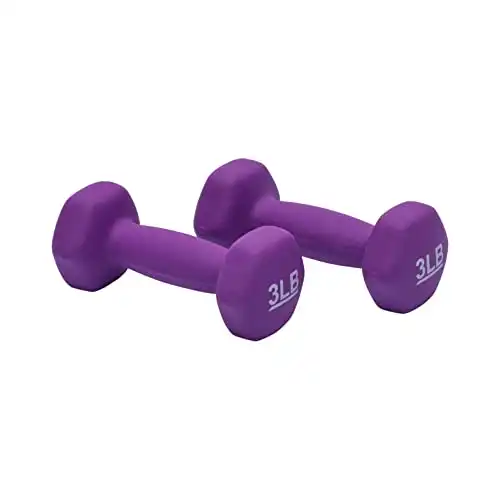
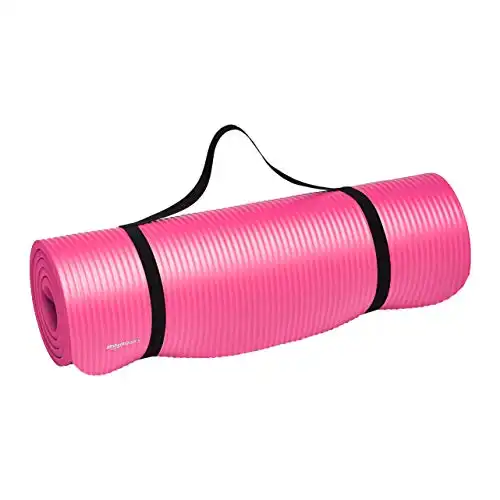




I have Gold and Premium. Is there a video that incorporates the above workout! I love the videos and along with my outside walks I have been doing the videos regularly
Hi Chris, I will be 69 next month. I have been excercising for years and over the past 10 years I have been going to a gym. For about two years I have been doing two HIIT classes a week 2 Bodyflow ( ti chi, yoga, Pilates combo) classes a week, and 3days of cardio on an elliptical (4 miles). I recently had cystocele and rectocele surgery….I have two more of my 6 week recovery time. My surgery was done vaginally with no mesh…just sutures. I have done really well….never needed pain meds, feeling blessed. My concern is getting back to my fitness workouts without causing another prolapse of my bladder. I’ve been reading about avoiding exercise that puts pressure on the pelvic floor….and so many do. Any suggestions for information you recommend to find answers? I know I have had a smooth recovery because of my fitness level and don’t want to lose that. Hormone depletion after menopause is often not addressed as a reason for potential thinning and weakening of the vaginal tissue leading to prolapse. I used compounded natural hormones from age 50 to 60, but my mother’s recurrence of breast cancer caused me to stop hormone therapy. This might be something to address. I know you are much younger, but I’m sure you have older followers. Thanks for your time and attention.
Hi Anne – thanks for your comment – yes as we age hormones do play a number on our bodies. Regarding your situation and surgery – I do not know enough about bladder surgeries to recommend anything for you … Pilates is sooo good for women in our 50-70s but if you are avoiding pressure on the pelvic floor – than Pilates is debatable for you. You may want to find out from your doctor if you can start with a beginners Pilates program and work your way up – the principal behind pilates is to preserve your pelvic floor and core muscles.
Also I would think walking would be good and maybe water aerobics? Most weight lifting will put pressure on the pelvic floor – so that’s why I am wondering if Pilates could be a starting place for you!
Hi, this is my 1st time seeing your pin. Unfortunately I haven’t done any strength training since 2011 when I was diagnosed with breast cancer. I am cancer free now! I do have Fibromyalgia though and it is extremely bad. My doctor said it’s one of the worst cases he’s ever seen, along with Chronic Fatigue Syndrome. Do you have any suggestions for me.
Waiting anxiously for your reply,
Mary Beth
Fibromyalgia can be hard – Typically thought of as a brain to body thing and the way your body feels and experiences pain … When being sensitive to pain – obviously I would not recommend high impact exercise. I would think that Pilates would be very helpful. I would think gentle yoga and walking would be good for you … but again you say severe so you will have to try things slowly. I would definitely seek out Pilates 🙂 !!
I am 55 years old. I did 5k races, yoga, Pilates, ect. On 12/12/2018 my Son committed Suicide. I just can’t get in to exercising again. I do fine somedays and others I donot. What shall I do?
Hi Valerie – I am sorry to hear about your loss. Think baby steps. You don’t need to be perfect and it’s okay if you skip a day or two. You will get yourself back but don’t beat yourself up and be gracious. Start by doing 1 day, then maybe 3 days a week. And if working out a few times a week isn’t where you struggle but it’s with how long you workout for, then start with just 10 minutes. Do something you LOVE doing! Whether that’s strength training or walking, do what your body loves and craves doing.
You gain weight because muscle is more heavy than fat. Keep the good diet a lot of veggies and eat good fats, avocados, olive oil, nuts, quality cheeses and fruits, good luck
I am getting back into shape right now. It hasn’t been easy, but I have been following a simple training program and have been very strict on myself. This post is a great motivation to keep pushing forward. I will add some of these exercises to what I am already doing.
I was told to never do a full body roll up. I have a bad low back. I would love your opinion. Thanks
Amazing article that was…keep it up
I have shoulder bursitis and shouldn’t lift my arms above my head (where I can’t see them) Any other shoulder exercises you would recommend?
Hi! Check this out: https://gethealthyu.com/best-exercises-for-shoulder-pain/
I have cervical spondylosis ,will that full body roll up create a problem?
Hi Marlene – I would definitely reach out to your doctor to make sure this is something that you could or should do. However, this movement might not feel the best on your cervical spondylosis. If this isn’t something that feels good on your spine, flip over and hold a plank! This might be a better option for you.